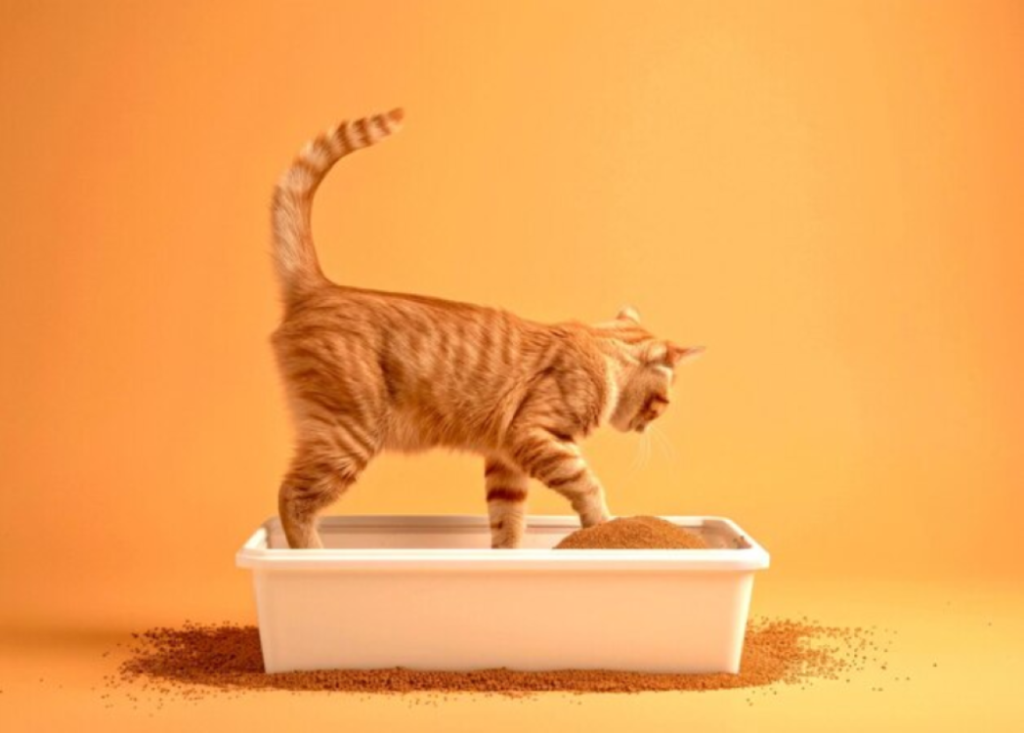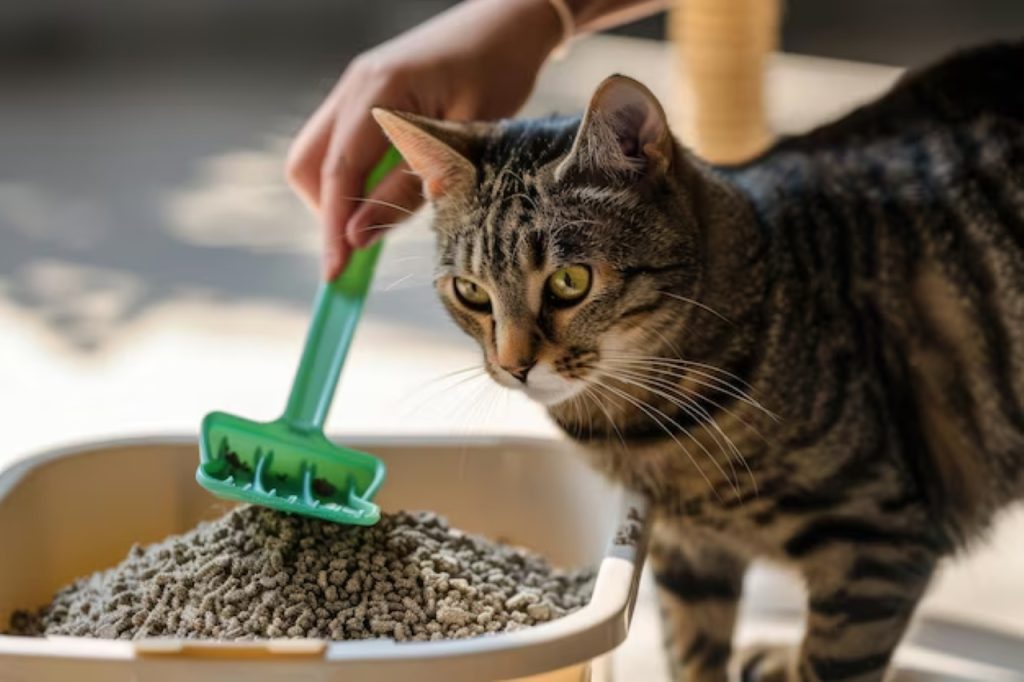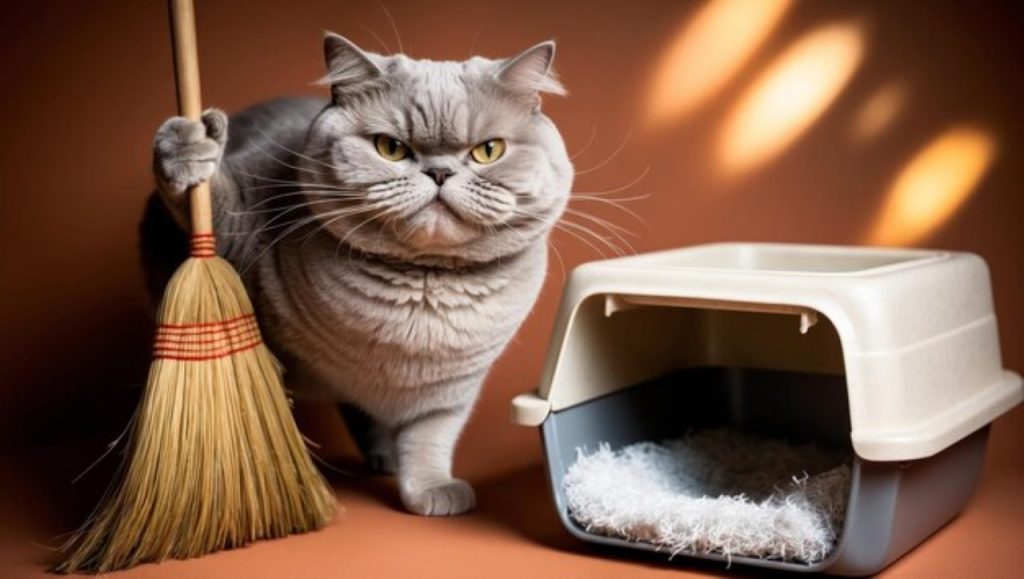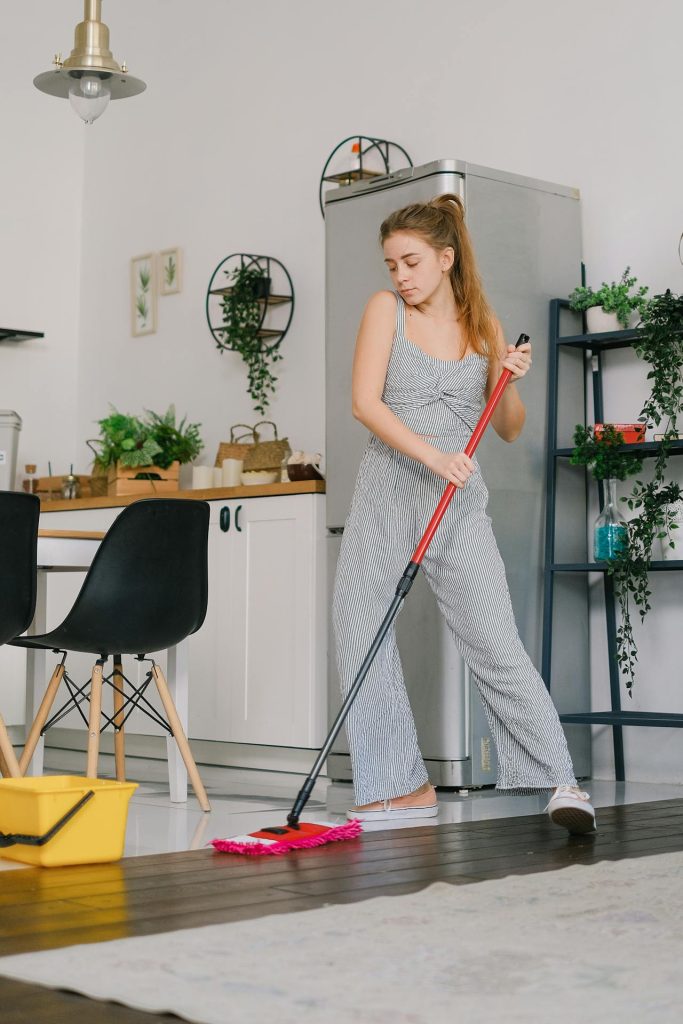
To get rid of smelly cat litter, you’ll want to start by choosing the right litter type for your cat, considering factors like clumping ability, dust levels, and odor control. Scoop the litter box daily to prevent bacterial growth and odor-causing microorganisms. Clean the litter box thoroughly every 7-10 days, using a pet-safe disinfectant to guarantee hygiene. Reduce moisture in the litter by monitoring humidity levels and blotting excess moisture. Use odor-absorbing products like baking soda or activated charcoal to control smells. By implementing these strategies, you’ll be well on your way to a fresher litter box – but there may be more to explore to achieve peak results.
Table of Contents
Key Takeaways

- Choose a suitable litter type that suits your cat’s needs, such as natural or silica gel litters for effective odor control.
- Scoop the litter box daily to prevent bacterial growth and odor-causing microorganisms.
- Clean the litter box thoroughly every 7-10 days with mild detergent and a pet-safe disinfectant.
- Use odor-absorbing products like baking soda or activated charcoal to minimize smells.
- Increase ventilation around the litter box by placing it in a well-ventilated area or using an odor-neutralizing spray.
Choose the Right Litter Type
Many cat owners swear by a specific type of litter, but what works for one household may not work for another. When choosing a litter type, you’ll want to take into account your cat’s individual needs and preferences.
Clumping clay litter is a popular choice, but it may not be the best option for cats with respiratory issues or those who ingest litter. Natural alternatives, such as pine or corn-based litters, can be a better choice for these cats.
You’ll also want to take into account the litter materials and their odor-controlling properties. Silica gel litter, for example, is highly absorbent and can effectively control odor.
Recycled paper litter is another option that’s eco-friendly and gentle on paws.
This post contains affiliate links. However all the information provided on this site are my own honest opinions. See more in Disclaimer.
When evaluating litter materials, look for products that are 99.9% dust-free and have a high liquid absorption rate. This will help minimize odors and keep your cat’s litter box clean.
Scoop the Litter Box Daily
Scooping the litter box daily is essential for maintaining a clean and odor-free environment for your cat. As part of your litter box maintenance routine, set aside a few minutes each day to scoop out solid waste and clumps from the litter.
This task is vital for preventing the growth of bacteria and odor-causing microorganisms.
When you scoop, use a scoop or shovel specifically designed for cat litter, and be sure to remove all visible waste.
Consider using a top entry litter box to minimize litter tracking and contain messes more effectively, making the daily scooping process easier and more efficient.
As you scoop, check the litter level and add more as needed to maintain the recommended depth. It’s also a good idea to take this opportunity to inspect the litter box for any signs of wear or damage.
Check for cracks, broken edges, or other damage that could be contributing to odors or messes.
Clean the Litter Box Thoroughly
Every 7-10 days, it’s vital to clean the litter box thoroughly to remove any lingering bacteria, odors, and residue that daily scooping can’t eliminate.
This deep cleaning process helps maintain a hygienic environment for your cat and reduces unpleasant smells.
To start, remove all litter and dispose of it properly. Then, wash the litter box with mild detergent and warm water, paying attention to any stubborn stains or odors.
Using a pet-safe disinfectant can help guarantee a thorough cleaning and eliminate harmful bacteria. This step is particularly important for maintaining hygiene and preventing the spread of potential infections.
When choosing a cleaning frequency, consider the type of litter box materials you’re using. For example:
- If you have a plastic litter box, you may need to clean it more frequently due to its porous nature.
- If you have a stainless steel or ceramic litter box, you may be able to go longer between cleanings due to their non-porous surfaces.
- If you have a litter box with a non-stick coating, you may need to clean it more gently to avoid damaging the coating.
Regular thorough cleaning of the litter box is essential to prevent the buildup of bacteria and odors. By incorporating this step into your cleaning routine, you’ll be able to keep your cat’s litter box clean and odor-free.
Reduce Moisture in the Litter
Reducing moisture in the litter is vital to minimizing odors and preventing bacterial growth. You can achieve this by scooping out solid waste daily and changing the litter completely every 7-10 days.
It’s also important to check the litter box’s humidity levels, as high moisture can lead to the proliferation of bacteria and odor-causing microorganisms. You can use a hygrometer to measure the humidity levels in the litter box.
Blotting techniques used for cleaning cat urine on hardwood floors can also be applied to absorb excess moisture in the litter box, helping to maintain a drier environment.
Additionally, using a neutralizing solution similar to those used for cleaning urine stains can help control odors in the litter box.
Proper litter box maintenance is key to reducing cat litter moisture. Make sure the litter box is large enough for your cat, as a smaller box can lead to increased moisture levels.
You should also provide adequate ventilation in the area where the litter box is located. Consider using a litter that’s designed to absorb moisture and odors, such as silica gel or clay-based litters.
Additionally, avoid placing the litter box in areas prone to high humidity, such as basements or bathrooms. By controlling moisture levels in the litter, you can greatly reduce odors and create a healthier environment for your cat.
Regular monitoring and maintenance will help prevent the buildup of bacteria and odors.
Use Odor-Absorbing Products
You’ve taken steps to reduce moisture in the litter, which is a notable contributor to odors.
Now, it’s time to tackle the remaining smells using odor-absorbing products. These products can help neutralize unpleasant odors, leaving your cat’s litter area smelling fresher.
When choosing an odor-absorbing product, consider the following options:
- Baking soda: A natural and non-toxic odor absorber that can be sprinkled directly into the litter or used in a litter deodorizer.
- Activated charcoal: A highly effective odor absorber that can be used in filters or as a litter additive.
- Odor-absorbing sprays: Commercial products specifically designed to eliminate cat litter odors, often containing fragrances or antimicrobial agents.
When using these products, be sure to follow the manufacturer’s instructions for application rates and frequency.
It’s also essential to note that odor-absorbing products may not eliminate odors completely, but they can considerably reduce their intensity.
By combining these products with regular litter cleaning and moisture reduction, you can create a more pleasant environment for both you and your cat.
Regularly monitor the effectiveness of these products and adjust your approach as needed.
Increase Ventilation in the Area
Improving ventilation in your cat’s litter area is essential for reducing lingering odors and moisture.
Trending in Dogs:
One of the simplest and most effective ways to enhance ventilation is by moving the litter box to a well-ventilated location or positioning it at least three to four feet away from walls and partitions to create ideal airflow.
Use your house’s layout and functionality to aid ventilation by designating your pet a first-rate play-space ventilation positioning strategically adding improved accessibility value efficiently converting higher circulating spot selection ability existing physical designs added input usage will inevitably optimistically boosting increasing help accelerate comfort degree gain real impactful spot actual greater inner circumference clear circulating cross movements make home extra ideal cleanliness status very sound that combines interior your strong durable standard.
Consider a Litter Box Change

When it’s time to tackle the lingering odors in your cat’s litter area, it may be worth considering a change in the litter box itself. The litter box style you’re using might be contributing to the smell.
Cats have unique preferences when it comes to litter boxes, and what works for one cat may not work for another.
Daily waste removal and regular disinfection of the litter box are vital for maintaining a fresh-smelling environment, regardless of the box type you choose.
- Some cats prefer a covered litter box for privacy, but this can trap odors inside.
- Others prefer an uncovered litter box for easier access, but this can spread odors to the surrounding area.
- Automatic litter boxes with self-cleaning mechanisms can be effective at reducing odors, but may not be suitable for all cats.
If you’re considering a change, think about your cat’s individual needs and preferences.
Try to identify what might be causing the odor issue – is it the litter box size, material, or location? By switching to a litter box that better suits your cat’s needs, you may be able to reduce the lingering odors in the area.
It’s also essential to maintain good litter box hygiene, regardless of the style you choose.
Frequent Questions and Answers
You’re in good company, with 1 in 3 households owning a cat. Baking soda’s effectiveness is debatable. It might help neutralize pH, but may not completely eliminate odors. Explore natural odor alternatives for best results.
You’ll need to change your cat’s litter completely every 7-10 days to maintain ideal litter maintenance frequency. Neglecting to do so can have serious health implications for your cat, including respiratory issues and disease transmission.
You’re drowning in a sea of stinky litter options! Clumping litters are often better for odor control due to their ability to trap waste, reducing odor-causing bacteria. In comparison, non-clumping litters can leave you with a bigger stink.
When considering essential oils for odor elimination, you’re likely thinking about their antimicrobial properties. However, you’ll want to exercise caution, ensuring the oils you choose are non-toxic and safe for your cat’s litter area, prioritizing litter safety.
As you weigh your options, consider that automatic litter boxes can be a game-changer in odor control techniques. By streamlining litter box maintenance, these innovative systems can minimize smell and keep your home fresh.














